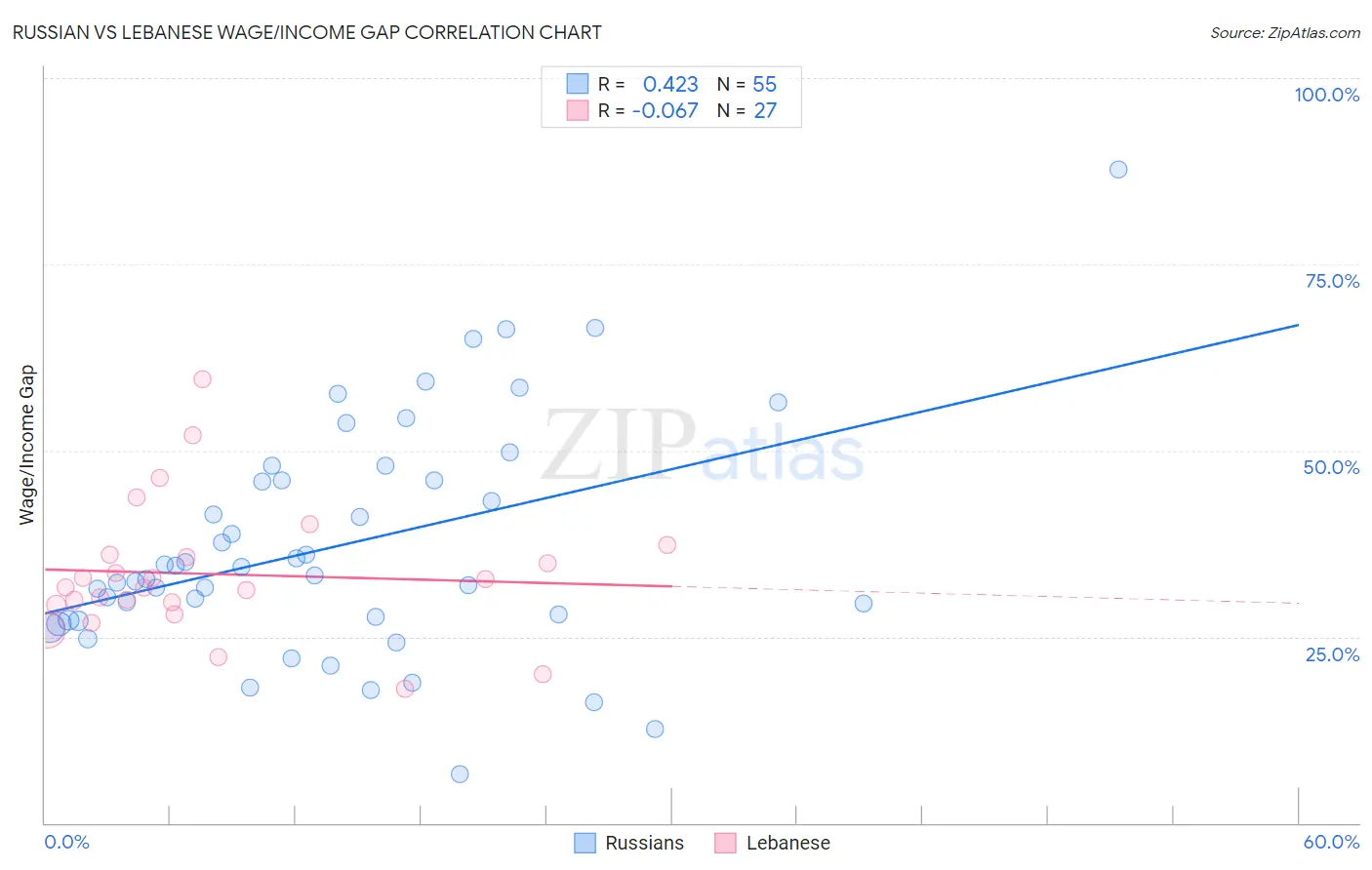Russian vs Lebanese Wage/Income Gap
COMPARE
Russian
Lebanese
Wage/Income Gap
Wage/Income Gap Comparison
Russians
Lebanese
28.0%
WAGE/INCOME GAP
0.5/ 100
METRIC RATING
280th/ 347
METRIC RANK
27.9%
WAGE/INCOME GAP
0.7/ 100
METRIC RATING
276th/ 347
METRIC RANK
Russian vs Lebanese Wage/Income Gap Correlation Chart
The statistical analysis conducted on geographies consisting of 511,171,536 people shows a moderate positive correlation between the proportion of Russians and wage/income gap percentage in the United States with a correlation coefficient (R) of 0.423 and weighted average of 28.0%. Similarly, the statistical analysis conducted on geographies consisting of 401,331,203 people shows a slight negative correlation between the proportion of Lebanese and wage/income gap percentage in the United States with a correlation coefficient (R) of -0.067 and weighted average of 27.9%, a difference of 0.47%.

Wage/Income Gap Correlation Summary
| Measurement | Russian | Lebanese |
| Minimum | 6.5% | 18.0% |
| Maximum | 87.7% | 59.6% |
| Range | 81.2% | 41.7% |
| Mean | 37.1% | 33.4% |
| Median | 33.2% | 31.7% |
| Interquartile 25% (IQ1) | 27.2% | 29.3% |
| Interquartile 75% (IQ3) | 46.0% | 36.0% |
| Interquartile Range (IQR) | 18.8% | 6.7% |
| Standard Deviation (Sample) | 15.5% | 9.1% |
| Standard Deviation (Population) | 15.3% | 8.9% |
Demographics Similar to Russians and Lebanese by Wage/Income Gap
In terms of wage/income gap, the demographic groups most similar to Russians are Burmese (28.0%, a difference of 0.050%), South African (28.0%, a difference of 0.080%), Romanian (28.0%, a difference of 0.15%), French Canadian (28.1%, a difference of 0.26%), and Immigrants from Sweden (28.1%, a difference of 0.26%). Similarly, the demographic groups most similar to Lebanese are Latvian (27.9%, a difference of 0.0%), Immigrants from Japan (27.9%, a difference of 0.030%), Immigrants from England (27.9%, a difference of 0.080%), American (27.8%, a difference of 0.11%), and Bulgarian (27.8%, a difference of 0.15%).
| Demographics | Rating | Rank | Wage/Income Gap |
| New Zealanders | 1.0 /100 | #268 | Tragic 27.7% |
| Potawatomi | 0.9 /100 | #269 | Tragic 27.7% |
| Immigrants | Western Europe | 0.9 /100 | #270 | Tragic 27.8% |
| Ute | 0.8 /100 | #271 | Tragic 27.8% |
| Immigrants | Korea | 0.8 /100 | #272 | Tragic 27.8% |
| Bulgarians | 0.7 /100 | #273 | Tragic 27.8% |
| Americans | 0.7 /100 | #274 | Tragic 27.8% |
| Immigrants | Japan | 0.7 /100 | #275 | Tragic 27.9% |
| Lebanese | 0.7 /100 | #276 | Tragic 27.9% |
| Latvians | 0.7 /100 | #277 | Tragic 27.9% |
| Immigrants | England | 0.6 /100 | #278 | Tragic 27.9% |
| Romanians | 0.5 /100 | #279 | Tragic 28.0% |
| Russians | 0.5 /100 | #280 | Tragic 28.0% |
| Burmese | 0.5 /100 | #281 | Tragic 28.0% |
| South Africans | 0.5 /100 | #282 | Tragic 28.0% |
| French Canadians | 0.4 /100 | #283 | Tragic 28.1% |
| Immigrants | Sweden | 0.4 /100 | #284 | Tragic 28.1% |
| Italians | 0.4 /100 | #285 | Tragic 28.1% |
| Immigrants | Austria | 0.4 /100 | #286 | Tragic 28.1% |
| Okinawans | 0.4 /100 | #287 | Tragic 28.1% |
| Choctaw | 0.4 /100 | #288 | Tragic 28.1% |